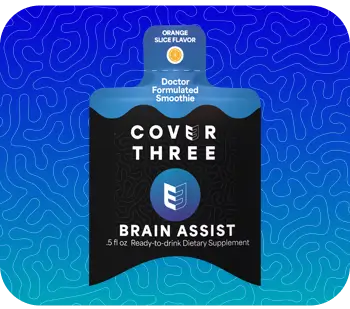|
|
What Is Neuroplasticity?Neuroplasticity is your brain's ability to rewire. It is part of normal growth and is shaped by your experiences. Neuroplastic changes occur both at the structural and functional levels.
At the functional level, neuroplasticity involves the following processes:
Neuroplasticity is either adaptive or maladaptive, depending on the neural pathways you habitually use when responding to stress. Activating brain pathways that enable you to cope well leads to adaptive neuroplasticity. It sharpens your cognitive function, balances your mood and keeps you motivated. But letting the stress get to you can give you maladaptive neuroplasticity, leading to persistent brain fog, depression, anxiety and loss of motivation. |
How Can Neuroplasticity Eliminate Brain Fog?As in other body cells, balance inside every neuron is important. When an imbalance sets in the adult brain, restoration occurs but only to a limited extent. Unlike sunburned skin, which renews easily, it takes a while for neurons to overcome an imbalance because:
“Neuroplastic changes can clear brain fog as they involve more than just cell regrowth. Moving the synapses around also improves brain function by creating new neural circuits. However, the speed of this process also depends on the number of intact neurons involved and how they are used.” |
Why Should You Get Rid of Brain Fog?Brain fog can keep you from successfully pursuing your goals, whether at home, work or school. You don’t get a lot of chances crushing a certification exam, getting a promotion or outwitting a chess grandmaster. What’s more, brain fog can be a symptom of a brewing mental health issue like Alzheimer’s disease or depression. So you should at least consult your doctor about it if it persists. For brain fatigue caused by everyday stress, natural fixes can safely bring back your mental focus. They can help keep your neurons healthy until well into your golden years. |
What Factors Can Boost Neuroplasticity?The main promoter of brain plasticity is brain-derived neurotrophic factor (BDNF), which affects all parts of the nerve cell. It is most abundant in the hippocampus and prefrontal cortex. The factors that increase BDNF levels act by one or a combination of the following mechanisms: Brain StimulationNeuronal excitation enhances BDNF, leading to synaptogenesis and LTP. Activities that can excite the neurons include brain exercises, physical activity, social interaction, etc. Decreased Blood SugarFasting exposes your brain to acute stress, which also boosts BDNF levels. Other activities that can lead to the peak ketotic state, like sleep, exercise, and the ketogenic diet, may also enhance BDNF release.
Stress ReductionChronic stress leads to the buildup of stress hormones in the body. It decreases BDNF levels and presents as cognitive impairment, depression and demotivation. Stress management by sleep, meditation, breathing exercises, etc. can push BDNF levels back to normal. Brain NourishmentResearch shows that some heart-healthy eats also directly benefit the brain. Proper nutrition is good for overall health, but your neurons need "brain-healthy nutrients" to protect them from chronic inflammation and early decline.
Increasing BDNF levels enhances brain health and leads to adaptive neuroplasticity. Both manifest clinically as hippocampal enlargement, cognitive improvement, mood balance and overall satisfaction with life . So if you want to rev up your weary neurons, boosting your BDNF may help. |
What Factors Can Curb Neuroplasticity?Exposures that can reduce neuroplasticity or produce maladaptive patterns include: Poor LifestyleChronic fatigue, emotional tension and lack of sleep all lead to chronic stress. Alcohol, smoking and bad dietary choices fry your neurons with toxins. Physical inactivity and too much screen time leave your brain unchallenged. All these can lower your BDNF levels. Environmental PollutionModern life has created many conveniences but has also damaged the environment. Pollutants can also poison your neurons, producing a wide range of symptoms—from subtle ones like forgetfulness to severe ones like unconsciousness. IllnessSickness can reduce neuroplasticity in various ways. Severe disease can produce symptoms of brain fog. They can go away or improve by combining medical care with rehabilitative therapy and good nutrition. These factors impair your neurons by inhibiting BDNF secretion, causing direct injury or both. Addressing them early limits the damage and maximizes the benefits of neuroplasticity.
|
Brain-Recovery Foods: How Crucial Is Nutrition in Overcoming Brain Fog?Nutrition directly impacts mental and athletic performance. For instance, nutritional deficiencies can damage the neurons, causing mental fatigue, weak senses, movement difficulties, etc. Doctors correct the deficit by vitamin or mineral supplementation. People can regain mental clarity and go back to their usual after medical therapy and rehabilitation. In cases where a nutrient deficiency is not the cause of brain fog, good nutrition always complements medical treatment. A brain-healthy diet helps restore the neurons by the following mechanisms:
Some nutrients are known to promote brain health and plasticity by stimulating BDNF secretion and other mechanisms. They include:
These nutrients' actions make them important neuroplasticity inducers. So if you want to recharge your brain, don't choose just any food. Choose brain fog foods and get a good helping of these vitamins. |
What Are the Best Brain Fog Foods to Kickstart Plasticity and Help Your Neurons Bounce Back?The MIND diet has been proven to enhance adaptive neuroplasticity and prevent cognitive decline.
You must likewise limit your intake of the following:
Experts agree that the MIND diet's success is more from the combined effects of multiple brain-healthy nutrients and not just one. Therefore, to jumpstart neuroplasticity and regain your mental focus, you need to make sure that you're getting these food groups in the recommended amounts.
Read what our clients say about Brain Assist. “Amazing! This stuff really works! I have used Cover Three for a couple of years now, and this is a great addition to their product line-up. I bought this for my mother, who has been struggling with her memory for a while now and has struggled even more since she had COVID. In just about a week of using this every day, she said she saw an improvement in her memory, and it feels like her head is clearer than it has been in a while. I'm excited to see how this continues to help as she uses it for an even longer period of time.” Joel Remember: the sooner you get your Brain Assist, the sooner you can give your neurons a reboot! |
ConclusionNeuroplasticity is the brain's main mechanism for restoring itself and getting rid of brain fog. It has adaptive and maladaptive forms. Neuroplasticity is activated by BDNF, a growth factor that increases with acute stress and decreases with chronic stress. Good nutrition also raises BDNF levels. The MIND diet is a nutritional strategy proven to enhance adaptive neuroplasticity, improve brain health and protect from cognitive decline. Experts agree that its effectiveness lies in the synergy between different BDNF enhancers and not just one. Doctor-formulated Brain Assist is the total neuroplasticity supplement that has them all. |

Brain Fog Foods
Brain Fog Foods
Get Brain Health Updates
Sign up for updates from our Brain Health Blog. Don’t worry, you’ll only get quality content from us and we’ll never share your email for any reason.

Get Brain Health Updates
Sign up for updates from our Brain Health Blog. Don’t worry, you’ll only get quality content from us and we’ll never share your email for any reason.





